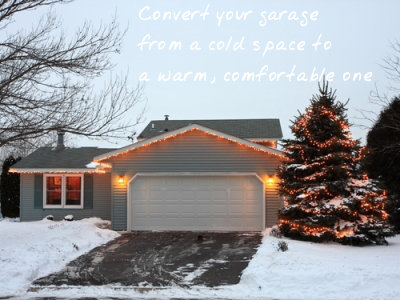The garage is a room that can be flooded with the cold weather once the garage door is opened. Furthermore, general heating and insulation may not be as good as it is in other parts of the house. If your garage is detached, then making sure you have good insulation will mean the difference between a cold space and an inviting, comfortable one.
Controlling Moisture in the Walls
Since the garage can get cold very quickly, many homes are designed to insulate the garage from other parts of the house. The effect is to keep the cold air from lowering the temperature in adjacent rooms and to make sure heat doesn’t leak out into the garage. The surfaces affected are walls and ceilings directly touching the walls of the garage. When warm air meets cold, condensation can form. In the walls, there is nowhere for the moisture to go. This moisture can damage the structure of the home and even encourage the growth of mold. This is where vapour barriers can help. So while taking all the necessary steps to keep your home warm during winter make sure that your garage is also a comfortable space.
Tip: Always install on the warm side of the wall.

Installing the Vapour Barrier
- Gather materials
- rolls of polyethylene
- industrial staples
- sheathing tape
- sealant or caulking
- Clean the room.
- Seal joints around outlets, windows, and doors.
- Stretch the polyethylene so that it’s taught against the wall, starting from the top, stapling along the way into the framing structure of the wall.
- Layer the polyethylene so there is overlap between the rows so that each framing member is covered by two layers.
- Cut around windows, doors, and electrical outlets, and tape to seal.
- Tape the polyethylene between the layers.
- Caulk along the bottom edge of the wall. Push the polyethylene into the calking.
- For the ceiling, repeat the process. Leave enough polyethylene along the edges to tape to the walls.
Applying Insulation to Keep Warm
It is important to observe building codes. The codes are there for your own safety. For example, in garages, there may be a rule about how the garage is built to keep any carbon monoxide from escaping into the house. The appropriate prevention usually involves using an air seal.
There is a variety of insulation available on the market. A spray foam can be a good choice, but may require a professional to apply. The most affordable option is probably fiberglass insulation. In addition, if you know the build of your home, you may know the measurements of the wall frame already. For common or standard frames, it’s possible to buy pre-cut batts. This will save you time and effort of measuring and cutting the material. Another option is rock wool, which is known for being fire retardant.
Tip: when choosing a product, check the R value. That is an indication of how well it retains heat. The higher the value, the better insulation it provides. It is important to choose a suitable value.
The installation of blanket insulation is similar to the vapour barrier. Ensure the paper edges exposed.
Following these tips will ensure that your garage is free from condensation and that the things you have stored in the garage storage units are safe. Also your garage becomes a space where you can hang out during the winter.
Author Bio:
